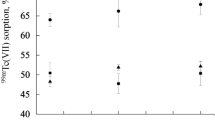Abstract
Today nanomaterials, including carbon ones, considered to be promising radionuclide carriers for nuclear medicine. We previously determined that nanodiamonds (NDs) have the best sorption properties in comparison to other carbon nanomaterials for the range of medical radionuclides including 90Y. At the same time, it was shown that the surface composition of NDs does not influence sorption and desorption for this isotope. In this work the influence of aggregate sizes of NDs and ζ-potential of their surface in water solutions on their sorption and desorption is studied, using 90Y as an example. It was determined that with the increase in aggregate sizes and decrease in ζ-potential the sorption decreases, which lets specify the mechanism of binding of 90Y to NDs. It was shown that creation of suspension with determined sizes of particles is an important task for the future use of NDs as medical radionuclide carriers.

Similar content being viewed by others
References
Bahadori SR, Mulgaonkar A, Hart R et al (2021) Radiolabeling strategies and pharmacokinetic studies for metal based nanotheranostics. Wiley Interdiscip Rev Nanomed Nanobiotechnol 13:1–44. https://doi.org/10.1002/wnan.1671
Siafaka PI, Okur N, Karantas ID et al (2021) Current update on nanoplatforms as therapeutic and diagnostic tools: A review for the materials used as nanotheranostics and imaging modalities. Asian J Pharm Sci 16:24–46. https://doi.org/10.1016/j.ajps.2020.03.003
Abd Elkodous M, El-Sayyad GS, Abdelrahman IY et al (2019) Therapeutic and diagnostic potential of nanomaterials for enhanced biomedical applications. Colloids Surf B Biointerfaces 180:411–428. https://doi.org/10.1016/j.colsurfb.2019.05.008
Rojas S, Gispert JD, Martín R et al (2011) Biodistribution of amino-functionalized diamond nanoparticles. in vivo studies based on 18F radionuclide emission. ACS Nano 5:5552–5559. https://doi.org/10.1021/nn200986z
Hong SY, Tobias G, Al-Jamal KT et al (2010) Filled and glycosylated carbon nanotubes for in vivo radioemitter localization and imaging. Nat Mater 9:485–490. https://doi.org/10.1038/nmat2766
Chen L, Zhong X, Yi X et al (2015) Radionuclide 131I labeled reduced graphene oxide for nuclear imaging guided combined radio- and photothermal therapy of cancer. Biomaterials 66:21–28. https://doi.org/10.1016/j.biomaterials.2015.06.043
Zhang S, Yang K, Feng L, Liu Z (2011) In vitro and in vivo behaviors of dextran functionalized graphene. Carbon 49:4040–4049. https://doi.org/10.1016/j.carbon.2011.05.056
Vardharajula S, Ali SZ, Tiwari PM et al (2012) Functionalized carbon nanotubes: biomedical applications. Int J Nanomed 7:5361–5374. https://doi.org/10.2147/IJN.S35832
Hartman KB, Hamlin DK, Wilbur DS, Wilson LJ (2007) 211AtCl@US-tube nanocapsules: a new concept in radiotherapeutic-agent design. Small 3:1496–1499. https://doi.org/10.1002/smll.200700153
Rosenblat TL, McDevitt MR, Mulford DA et al (2010) Sequential cytarabine and α-particle immunotherapy with bismuth-213-lintuzumab (HuM195) for acute myeloid leukemia. Clin Cancer Res 16:5303–5311. https://doi.org/10.1158/1078-0432.CCR-10-0382
Kamkaew A, Ehlerding EB, Cai W (2019) Radiopharmaceutical chemistry. Springer, Cham. https://doi.org/10.1007/978-3-319-98947-1
Jeon J (2019) Review of therapeutic applications of radiolabeled functional nanomaterials. Int J Mol Sci 20:2323. https://doi.org/10.3390/ijms20092323
Qi W, Li Z, Bi J et al (2012) Biodistribution of co-exposure to multi-walled carbon nanotubes and nanodiamonds in mice. Nanoscale Res Lett 7:1–9. doi:https://doi.org/10.1186/1556-276X-7-473
Peltek OO, Muslimov AR, Zyuzin MV, Timin AS (2019) Current outlook on radionuclide delivery systems: from design consideration to translation into clinics. J Nanobiotechnol 17:1–34. https://doi.org/10.1186/s12951-019-0524-9
Ruggiero A, Villa CH, Holland JP et al (2010) Imaging and treating tumor vasculature with targeted radiolabeled carbon nanotubes. Int J Nanomed 5:783–802. https://doi.org/10.2147/IJN.S13300
Jiang DW, Peng C, Sun YH et al (2015) Study on technetium-99m labeling of graphene oxide nanosheets through click chemistry-99mTc labeling of graphene oxide nanosheets. Nucl Sci Tech 26:1–5. https://doi.org/10.13538/j.1001-8042/nst.26.040301
Jaymand M, Davatgaran Y, Rezaei A, Derakhshankhah H (2021) Radiolabeled carbon-based nanostructures: new radiopharmaceuticals for cancer therapy? Coord Chem Rev 440:213974. https://doi.org/10.1016/j.ccr.2021.213974
Kazakov AG, Garashchenko BL, Yakovlev RY et al (2020) An experimental study of sorption/desorption of selected radionuclides on carbon nanomaterials: a quest for possible applications in future nuclear medicine. Diam Relat Mater 104:107752. https://doi.org/10.1016/j.diamond.2020.107752
Kazakov AG, Garashchenko BL, Babenya JS et al (2020) Nanodiamonds and carbon nanotubes as perspective carriers of bismuth isotopes for nuclear medicine. In: RAD Conference Proceedings, pp 1–6
Kazakov AG, Garashchenko BL, Yakovlev RY et al (2020) Generator of Actinium-228 and a study of the sorption of Actinium by carbon nanomaterials. Radiochemistry 62:592–598. https://doi.org/10.1134/S1066362220050057
Kazakov AG, Garashchenko BL, Ivanova MK et al (2020) Carbon nanomaterials for sorption of 68Ga for potential using in positron emission tomography. Nanomaterials 10:1090. https://doi.org/10.3390/nano10061090
Kazakov AG, Babenya JS, Ivanova MK et al (2021) Study of 90Y Sorption by nanodiamonds as potential carriers in radiopharmaceuticals. Radiochemistry (in press)
Ma J, Wang C, Xi W et al (2021) Removal of radionuclides from aqueous solution by manganese dioxide-based nanomaterials and mechanism research: a review. ACS ES&T Eng 1:685–705. https://doi.org/10.1021/acsestengg.0c00268
Liu X, Pang H, Liu X et al (2021) Orderly porous covalent organic frameworks-based materials: superior adsorbents for pollutants removal from aqueous solutions. Innovation 2:100076. https://doi.org/10.1016/j.xinn.2021.100076
Pichestapong P, Sriwiang W, Injarean U (2016) Separation of yttrium-90 from strontium-90 by extraction chromatography using combined Sr Resin and RE Resin. Energy Procedia 89:366–372. https://doi.org/10.1016/j.egypro.2016.05.048
Qiu M, Wang M, Zhao Q et al (2018) XANES and EXAFS investigation of uranium incorporation on nZVI in the presence of phosphate. Chemosphere 201:764–771. https://doi.org/10.1016/j.chemosphere.2018.03.057
Qiu M, Liu Z, Wang S, Hu B (2020) The photocatalytic reduction of U(VI) into U(IV) by ZIF-8/g-C3N4 composites at visible light. Environ Res 196:110349. https://doi.org/10.1016/j.envres.2020.110349
Hu B, Wang H, Liu R, Qiu M (2021) Highly efficient U(VI) capture by amidoxime/carbon nitride composites: Evidence of EXAFS and modeling. Chemosphere 274:129743. https://doi.org/10.1016/j.chemosphere.2021.129743
Acknowledgements
This paper was written according to state task of GEOKHI RAS № 0137-2019-0022.
Author information
Authors and Affiliations
Corresponding author
Additional information
Publisher’s Note
Springer Nature remains neutral with regard to jurisdictional claims in published maps and institutional affiliations.
Rights and permissions
About this article
Cite this article
Babenya, J.S., Kazakov, A.G., Ekatova, T.Y. et al. The dependence of 90Y sorption on nanodiamonds on sizes of their aggregates in water solutions . J Radioanal Nucl Chem 329, 1027–1031 (2021). https://doi.org/10.1007/s10967-021-07808-7
Received:
Accepted:
Published:
Issue Date:
DOI: https://doi.org/10.1007/s10967-021-07808-7




